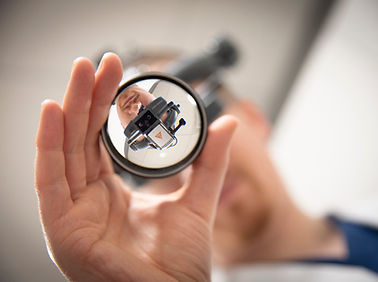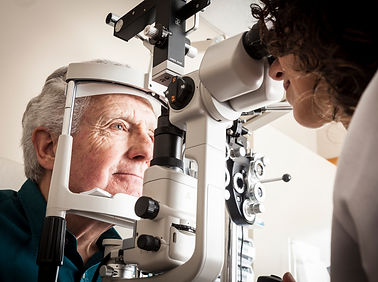
Chirurgie de la cataracte
La chirurgie oculaire peut semer plusieurs questionnements ou inquiétudes. Nous avons recueilli pour vous la plus récente information pour répondre à vos interrogations. Vous trouverez ci-dessous des vidéos explicatifs sur la chirurgie de la cataracte, les détails d'une visite préopératoire, ainsi que les choix de lentilles intra-oculaires disponibles pour votre chirurgie.

01
La visite préopératoire
La visite préopératoire se déroule en deux étapes lors d'une même rencontre.
Lors de la première partie du rendez-vous, vous rencontrerez un de nos assistants qui se chargera d'effectuer des examens d'imagerie nécessaire à la planification de votre chirurgie. Certains des examens peuvent engendrer des frais non couverts par la RAMQ.
Lors de la deuxième partie du rendez-vous, vous rencontrerez le chirurgien qui vous a été attitré. Celui-ci effectuera l'examen de vos yeux, procédera à l'analyse de vos tests, vous expliquera la chirurgie et ses risques et passera en revue vos besoins pour trouver une lentille intraoculaire adaptée à votre situation.
Vérifiez ici les consignes à retenir pour bien vous préparer à ce rendez-vous.
02
Les lentilles intra-oculaires
Une variété de lentilles intra-oculaires est disponible sur le marché. Les chirurgiens de la clinique ont effectué une présélection pour vous.
Monofocale
La lentille monofocale corrige la vision de loin. La correction de la vision intermédiaire et de près doit se faire avec des lunettes.
À Plage étendue
La lentille à plage étendue corrige la vision de loin et la vision intermédiaire. La correction de près doit se faire avec des lunettes.
Multifocale
La lentille multifocale permet la correction de la vision de loin, intermédiaire et de près. Elle comporte par contre certaines particularités et contre-indications qui doivent être discutées avec votre chirurgien.
Torique
Le lentille torique permet la correction de l'astigmatisme cornéen (puissance de la cornée différente à l'horizontale et à la verticale). Il est possible d'intégrer cette correction dans la lentille monofocale, à plage étendue et multifocale.
Des frais d'imageries, d'installation et de lentille peuvent s'appliquer pour les lentilles autres que monofocales.
Il est à noter qu'aucune garantie de vision sans lunettes ne peut être donnée quant au résultat final de votre opération, et ce, peu importe le type de lentille choisi.

Étendue de la vision
Vision de loin
Plus de 2 mètres
Télévision, paysages
Vision intermédiaire
65 cm à 2 m
Ordinateur de bureau, tableau de bord de la voiture
Vision de près
40 à 65 cm
Livre, téléphone cellulaire
03
La chirurgie
La chirurgie de la cataracte est une intervention sécuritaire se déroulant dans une salle d'opération afin d'assurer la stérilité de l'environnement. L'intervention sera effectuée sous anesthésie locale au niveau de l'œil seulement.
Le chirurgien effectuera deux petites incisions sur la surface de votre œil afin de retirer votre cataracte à l'aide d'ultrasons. Il remplacera ensuite le cristallin par la lentille intra-oculaire que vous aurez choisie.
Cliquer ici pour afficher les consignes à suivre en préparation à une chirurgie de la cataracte.
04
Le suivi post-opératoire
Un premier suivi postopératoire se fera 24 heures après votre chirurgie pour s'assurer de la sécurité de votre œil.
Un deuxième suivi postopératoire se fera environ deux semaine après la chirurgie pour vérifier la guérison de votre œil et planifier la chirurgie de votre deuxième œil si applicable.
Par la suite, votre chirurgien vous indiquera si d'autres examens de suivi sont nécessaires tout dépendant de la santé globale de votre œil.
Cliquer ici pour afficher les consignes à suivre à la suite d'une chirurgie de la cataracte.

